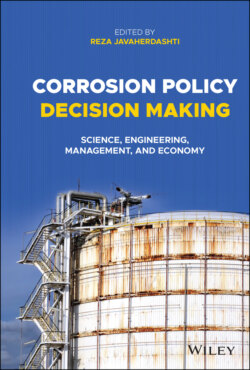Читать книгу Corrosion Policy Decision Making - Группа авторов - Страница 26
2.2.5.2 Features of Substrate
ОглавлениеThe material of substrate and shape of a surface are effective limits to useful life of coating and paint systems [7]. In industrial facilities, some base metals and sub‐surfaces include; steel, stainless steel, cast iron, galvanized steel, aluminum, zinc, copper, concrete, etc. The corrosion mechanisms of these substrates are various and each requires a different method of surface preparation before application of the coatings [7]. Stainless steel, zinc, and aluminum corrode slowly under the atmospheric condition [8].
Steel has a dense and smooth surface. It also has a high chemical reactivity with the atmosphere and pollutants. Therefore, complete de‐rusting along with enough roughness are necessary in surface preparation.
Stainless steel 304 has 18–20% chromium by weight [8]. It has a much harder surface under normal atmospheric conditions than carbon steel, is smoother and denser, and is more resistant to corrosion under normal atmospheric conditions. It has many applications in atmospheric environments. Stainless steel strikes the rust point in an atmosphere containing chlorine and sulfur, however, it is more difficult for the coating to adhere to it. It is therefore recommended that you perform a weak and suitable acid wash on the surface of stainless steel before sand blasting, for proper adhesion of the primer [7].
Concrete is not dense and has a rough surface; its surface is porous and is vulnerable to the attack of undesirable chemicals such as acid, alkaline, and hydration of cement due to its surface pores. Therefore, it is necessary to create surface uniformity with the help of sealers which add consistency to the coatings. Concrete is also very sensitive to the application of acid base coatings.
Aluminum is a metal that has a dense and smooth surface covered with a layer of aluminum oxide. Alkaline materials degrade aluminum surfaces, and surface coatings on aluminum are less durable in alkaline environments. On the other hand, sulfur has many corrosive effects on iron, copper, silver, and lead substrates, but it is almost ineffective on aluminum; and coated aluminum is less problematic in a sulfur environment. One of the problems with aluminum substrate is the difficulty of paint adhesion on it. Anodizing is suitable for workshop treatments, but to overcoming this problem in the field, some chemical treatments and soft blasting are recommended.
Galvanized steel is prepared by hot or electrogalvanized zinc spray and provides better corrosion resistance in atmospheric environments. In the acidic environment, zinc reacts rapidly with acidic agents, and forms a white layer of zinc chloride on the surface in a chlorine‐containing environment. If ions pass through the paint system layers on galvanized steel, whitening and surface porosity will appear.
A thin, pale green outer layer variously forms on the surface of copper by oxidation or other chemical processes, and is called a patina [9]. Although the patina can give a protective covering to the surface, it should be removed before painting.
Due to the high density and smoothness of copper surface, adhesion of the coatings to copper is weak. Copper has very good resistance in atmospheric conditions but is very sensitive in sulfur and acidic environments. It is recommended that the surface is prepared with a soft blasting and applying a very resistant coating for these environments.
Cast iron has from 1.8 to 6% carbon, and it provides a rather rough, porous surface, but it is much harder and brittle than the steel. Adhesion of coatings is weak, and the phenomenon of graphite corrosion is a major problem in immersed or buried conditions [7]. Sand blasting and using a suitable paint and coating system is essential.
Some examples of coating degradation on various substrates shown in the Figure 2.8.
Figure 2.8 Paint degradation on various substrates. (a) Rust on stainless steel in an oil platform in the Persian Gulf. (b) Rust on water‐line copper pipes in a gas processing unit. (c) Paint defect on cast iron.
